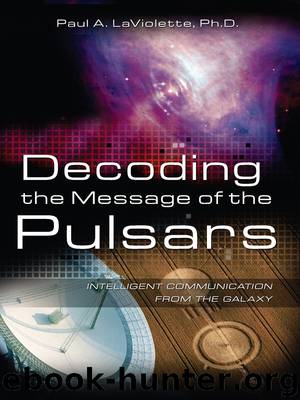Decoding the Message of the Pulsars by Paul A. LaViolette Ph.D

Author:Paul A. LaViolette, Ph.D.
Language: eng
Format: epub
Publisher: Inner Traditions / Bear & Company
Published: 2011-10-03T16:00:00+00:00
SEVEN
NATURAL OR ARTIFICIAL
Lighthouse Trouble
Supernova Origin Problem. Although astronomers continue to use the neutron star lighthouse model to interpret the pulsar phenomenon, they readily admit there are many things this model leaves unexplained. One shortcoming is that it fails to explain how pulsars originate. The lighthouse model predicts they should be formed in supernova explosions. However, there is a lack of evidence of pulsars residing within or near existing supernova remnants. Although 3 percent of the known pulsars have been found to coincide with remnants, a supernova cause remains uncertain, even for these few. In the case of the Vela and Vulpecula pulsars, the evidence contradicts the idea that they were formed by the explosion that produced their associated remnants. As was noted in chapter 5, the trajectory of the Vela pulsar is not aligned with the explosion center of the Vela supernova remnant. Nor could it have covered the distance from that site to its present location in the 13,000 years since the time of the Vela supernova explosion. Also, it is not certain that the Vela pulsar is located at the same distance as the Vela supernova remnant. By noting the frequency-dependent time lag of its radio signals, astronomers had estimated the pulsar should lie about 1,650 light-years away. But this is twice as far away as the estimated distance to the Vela remnant.
Astronomers concur that a causal connection between the Vulpecula pulsar and its remnant is doubtful as well because, judging from its large size, the remnant appears to be much too old in comparison with the pulsar. The only case where a pulsar can convincingly be shown to have originated from the center of a supernova explosion site is the Crab pulsar. But this does not prove that it is a spinning neutron star. The source may simply be the remnant core of the exploded progenitor star. The non-pulsing point X-ray source found inside the Cassiopeia A remnant close to its supernova explosion site could similarly be the hot remnant core of that exploded star as well.
Circular Orbit Problem. Pulsar astronomers have been surprised to find that a large percentage of pulsars are associated with an orbiting companion, for if pulsars are formed in supernova explosions, as their theory predicts, any nearby celestial bodies should have become propelled far from the explosion site and from the newly formed neutron star. For this reason, astronomers assume that a pulsar acquires its companions after the explosion through gravitational capture of closely passing bodies. In such a case, the captured planets or stars should have highly elliptical orbits much like short-period comets orbiting the Sun. But contrary to this expectation, most binary pulsars are orbited by bodies that follow exceedingly circular orbits. One example is pulsar PSR 1257+12, which is found to be associated with two planets, each 3 to 4 times the mass of the Earth, which follow highly circular orbits around the pulsar.1 Another pulsar, PSR 0329+54, is orbited by a companion having an even lower mass, somewhere between 6 and 57 percent of the Earth’s mass.
Download
This site does not store any files on its server. We only index and link to content provided by other sites. Please contact the content providers to delete copyright contents if any and email us, we'll remove relevant links or contents immediately.
| Aeronautics & Astronautics | Astronomy |
| Astrophysics & Space Science | Comets, Meteors & Asteroids |
| Cosmology | Mars |
| Solar System | Star-Gazing |
| Telescopes | UFOs |
Tools of Titans by Timothy Ferriss(8216)
Turbulence by E. J. Noyes(7935)
Secrets of Antigravity Propulsion: Tesla, UFOs, and Classified Aerospace Technology by Ph.D. Paul A. Laviolette(5309)
Astrophysics for People in a Hurry by Neil DeGrasse Tyson(5130)
Room 212 by Kate Stewart(5035)
Design of Trajectory Optimization Approach for Space Maneuver Vehicle Skip Entry Problems by Runqi Chai & Al Savvaris & Antonios Tsourdos & Senchun Chai(5011)
Pale Blue Dot by Carl Sagan(4912)
The David Icke Guide to the Global Conspiracy (and how to end it) by David Icke(4624)
A Journey Through Divination and Astronomy by Publishing Pottermore(4344)
Goodbye Paradise(3726)
Apollo 8 by Jeffrey Kluger(3636)
COSMOS by Carl Sagan(3554)
Losing the Nobel Prize by Brian Keating(3498)
The Five People You Meet in Heaven by Mitch Albom(3474)
How to Read Water: Clues and Patterns from Puddles to the Sea (Natural Navigation) by Tristan Gooley(3406)
Brief Answers to the Big Questions by Stephen Hawking(3369)
How to Read Nature by Tristan Gooley(3249)
The Order of Time by Carlo Rovelli(3145)
A Brief History of Time by Stephen Hawking(2960)
